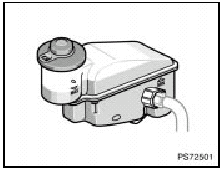 Toyota Yaris: Checking brake fluid
Toyota Yaris: Checking brake fluid

Before checking or adding the brake fluid, remove the cover. (See “(c) Jump starting”).
To check the fluid level, simply look at the see-through reservoir. The level should be between the “MAX” and “MIN” lines on the reservoir.
It is normal for the brake fluid level to go down slightly as the brake pads wear. So be sure to keep the reservoir filled.
If the reservoir needs frequent refilling, it may indicate a serious mechanical problem.
If the level is low, add SAE J1703 or FMVSS No.116 DOT 3 brake fluid to the brake reservoir.
Remove and replace the reservoir cap by hand. Fill the brake fluid to the dotted line. This brings the fluid to the correct level when you put the cap back on.
Use only newly opened brake fluid. Once opened, brake fluid absorbs moisture from the air, and excess moisture can cause a dangerous loss of braking.
CAUTION.
Take care when filling the reservoir because brake fluid can harm your hands or eyes. If fluid gets on your hands or in your eyes, flush the affected area with clean water immediately.
If you still feel uncomfortable with your hands or eyes, go to the doctor.
NOTICE.
If you spill some of the fluid, be sure to wipe it off to prevent it from damaging the parts or paintwork.
 Checking the radiator and condenser
Checking the radiator and condenser
If any of the above parts are extremely dirty or you are not sure of their condition,
take your vehicle to a Toyota dealer.
CAUTION.
To prevent burning yourself, be careful not to touch the radiat ...
 Checking tire inflation pressure
Checking tire inflation pressure
Keep your tire inflation pressures at the proper level.
The recommended cold tire inflation pressures, tire sizes and the combined weight
of occupants and cargo (vehicle capacity weight). They ...
See also:
Body dimension drawings
ENGINE COMPARTMENT Hatchback
ENGINE COMPARTMENT Sedan
BODY OPENING AREAS (Side View) Hatchback 3 Door
BODY OPENING AREAS (Side View: Front) Hatchback 5 Door
BODY OPENING AREAS (Side View: ...
Front door outer panel (CUT): 5-Door
REPLACEMENT
REMOVAL
INSTALLATION
Temporarily install the new parts and measure each part of the new parts in accordance
with the body dimension diagram. (See the body dimension diagram) Inspe ...
Important health and safety information about your Toyota
CAUTION.
WARNING: Engine exhaust, some of its constituents, and a wide variety of automobile
components contain or emit chemicals known to the State of California to cause cancer
and birth defect ...
